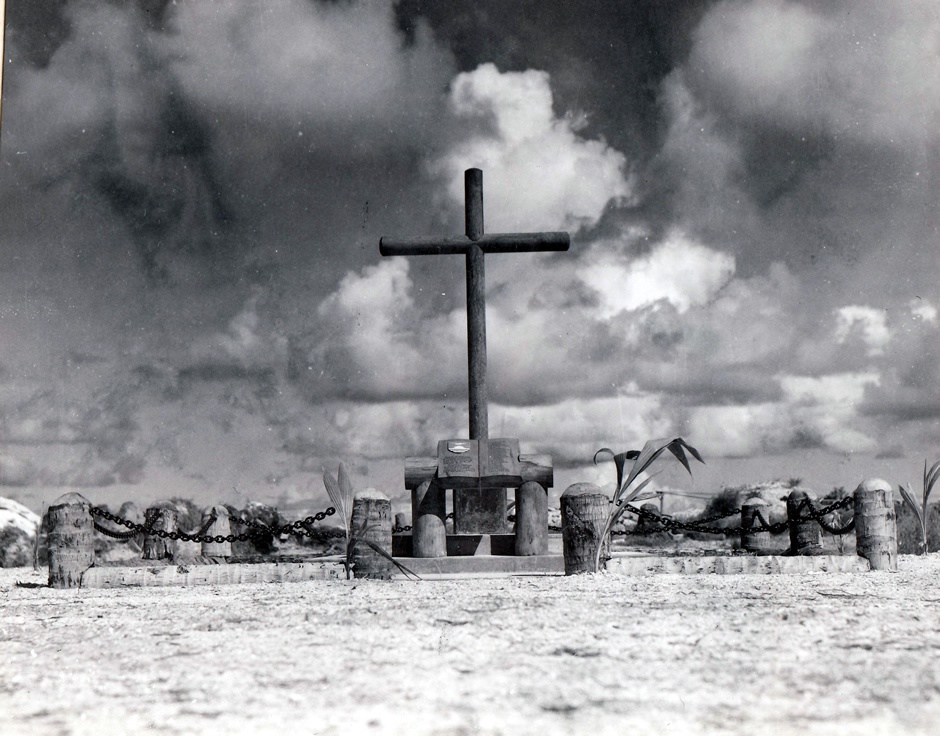During 1941 a small group of New Zealand coast-watchers, mainly civilian volunteers from the Post and Telegraph Department, were stationed in the Gilbert Islands (Kiribati). They formed part of a forward line of listening posts intended to intercept Japanese radio signals – which could be decoded by the US Navy’s Communication Special Unit and the US Army’s Signals Intelligence Service – and provide early warning of any movements by Japanese naval forces into the Pacific. The subsequent murder of these civilians at the hands of the Japanese remains one of the little-known – but poignant – stories of the naval war in the Pacific.
The general plan to establish forward observation posts had been devised during a joint US-British defence conference held early in 1939 in Wellington, New Zealand. In May 1941, plans were laid to extend the coast-watching network to the Gilbert and Ellice Islands, then a British possession. War had yet to break out with Japan, but tensions were climbing on the back of Japan’s invasion of Indochina and a US-British embargo. New Zealand took a lead role in the coast-watching effort. Ten listening posts were set up across the Gilberts, and volunteer radio operators called for from the New Zealand Post and Telegraph Department.
In late July the minesweeper HMFS Viti took the watchers to the island group. All were unarmed, as were the soldiers from the Reserve Battalion sent to accompany them.[1] War with Japan broke out on 7 December, and the next day a Japanese force arrived off Ocean (Banaba) Island in the southern Gilberts and shelled it. One of the New Zealand coast-watchers, P. B. Thorburn, was in hospital, but insisted on returning to duty when the raid began.
Two days later, Japanese forces captured the coast-watchers in the northern Gilberts. Those in the southern islands were left alone. All but one New Zealander, Sergeant Ron Third, were evacuated from Ocean Island in February 1942.
The Japanese took the southern Gilberts in late August 1942, again shelling Ocean Island and capturing Ron Third. Their arrival was reported by the coast-watchers who ‘kept going to the end…regardless of their own safety’.[2] Seventeen New Zealanders – seven civilian wireless operators and ten soldiers – were taken prisoner by the Japanese and moved to Betio island, part of Tarawa atoll, where they were joined by five New Zealand civilians already captured there. The prisoners were tied to coconut trees for three days before being incarcerated in the local psychiatric asylum, and put to work under guard from an armed Korean labouring force, moving gravel, building a wharf, or unloading ships.[3]
On 15 October, however, the cruiser USS Portland (CA-33) arrived off Tarawa and attacked Japanese shipping.[4] During the raid one of the prisoners apparently escaped and began waving at US aircraft flying overhead.[5] He was shot dead by the Korean labourers. Around 5 pm their commander, a Japanese civilian, had the New Zealanders gathered up in the asylum enclosure and summarily executed them – personally beheading each man with his sword. The scene was apparently horrific; one witness, an islander, reported later that he fainted at the sight.[6]
The massacre has often been put down to revenge for the US attack, but it could equally have been a reprisal for the escape earlier – or, indeed, both. Either way it was a war crime. The Post and Telegraph men were civilians. Although rumours circulated, their fate remained officially unknown in New Zealand for some time. US forces recaptured Tarawa in November 1943, but it was not until late 1944 – after an official investigation – that the story of the execution emerged. The news was formally broken to New Zealand by the Prime Minister, Peter Fraser.[7] The civilians had already been given retrospective military rank so their families could access war pensions.[8]
Third also died, captured on Ocean Island, bringing the total lost to 23. A memorial was raised to them on Tarawa by US and British forces, bearing an inscription that read in part: ‘Standing unarmed at their posts, they matched brutality with gallantry, and met death with fortitude’. When the war ended there were calls for those responsible for the murders to be put on trial as war criminals.[9]
So ended a little-known chapter in the Pacific naval war. But the men were not forgotten. A memorial to them was designed by Jasmax Landscape Architects and erected outside New Zealand Post headquarters in central Wellington. It was unveiled by 94-year old John Jones, the last surviving Gilbert Islands coast-watcher, in October 2014.[10]
For more on the Pacific war, check out my book Pacific War: New Zealand and Japan 1941-45. Click to buy.
Copyright © Matthew Wright 2019
[1] K. L. Sandford, Story of the 34th, A. H. & A. W. Reed, Wellington 1947, p. 33.
[2] D. O. W. Hall, ‘Coastwatchers’, in Episodes & Studies, Volume 2, Historical Publications Branch, Wellington, p. 26.
[3] Ibid, p. 27.
[4] https://ww2db.com/ship_spec.php?ship_id=900, accessed 14 August 2019.
[5] Hall, p. 27.
[6] Ibid.
[7] Sandford, pp. 33-34.
[8] Hall, p. 27.
[9] Evening Post, 15 August 1945.
[10] https://www.jasmax.com/news/gilbert-islands-coast-watchers-memorial-unveiled/, accessed 14 August 2019.
